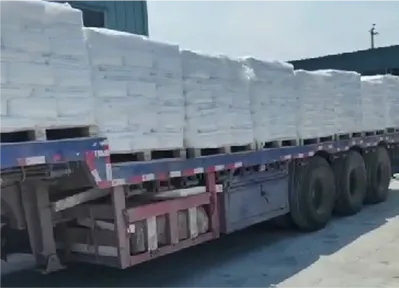
чэрв . 11, 2025 10:11 Вярнуцца да спісу
Using Titanium Dioxide to Enhance the Opacity and Smoothness of Paper
In the paper manufacturing industry, achieving optimal opacity and smoothness is crucial for producing high-quality printing, packaging, and specialty papers. One of the most effective additives for improving these properties is titanium dioxide (TiO₂), a versatile white pigment widely used in coatings and fillers. Whether sourced from leading пастаўшчыкі парашка дыяксіду тытана or applied as a titanium dioxide coating, TiO₂ plays a pivotal role in enhancing paper performance.

The Science Behind Titanium Dioxide in Paper Manufacturing
Superior Light Scattering for Enhanced Opacity
Opacity is a critical factor in paper quality, particularly for printing and packaging applications where show-through (visibility of text or images from the reverse side) must be minimized. Titanium dioxide pigment excels in this regard due to its exceptionally high refractive index (2.7 for rutile TiO₂), which allows it to scatter light more efficiently than other fillers like calcium carbonate or clay. When incorporated into paper, TiO₂ particles reflect and refract light, preventing it from passing through the sheet and thereby increasing opacity.
Unlike lower-refractive-index fillers, which require higher loading levels to achieve similar opacity, titanium dioxide coating allows manufacturers to use smaller quantities while still achieving superior results. This efficiency reduces material costs and maintains paper strength without excessive filler content.
Brightness and Whiteness Enhancement
In addition to opacity, titanium dioxide pigment significantly improves paper brightness—a key quality metric for premium printing papers, labels, and packaging. TiO₂’s inherent whiteness and ability to reflect a broad spectrum of visible light contribute to a brighter, more visually appealing sheet. This is particularly important for applications like photographic paper, book publishing, and luxury packaging, where color accuracy and vibrancy are essential.
Paper manufacturers often combine TiO₂ with optical brightening agents (OBAs) to achieve an even higher degree of whiteness. However, titanium dioxide paint coating remains the foundation for brightness enhancement due to its stability and resistance to yellowing over time.
Improving Surface Smoothness with Titanium Dioxide Coatings
The Role of TiO₂ in Coating Formulations
Beyond its use as a filler, titanium dioxide coating is a key component in paper surface treatments. Coated papers, used in high-end printing and packaging, rely on smooth, uniform surfaces to ensure sharp image reproduction and ink adhesion. TiO₂ particles, when finely ground and evenly dispersed in coating formulations, fill microscopic voids in the paper fibers, creating a smoother, more uniform surface.
The particle size and distribution of titanium dioxide pigment are carefully controlled to optimize coating performance. Leading пастаўшчыкі парашка дыяксіду тытана provide specialized grades with narrow particle size distributions to ensure consistent smoothness and gloss in the final product.
Enhanced Printability and Ink Holdout
A smooth, TiO₂-enhanced surface improves printability by providing better ink holdout—meaning ink sits on the surface rather than being absorbed unevenly into the paper fibers. This results in sharper text, richer colors, and higher-resolution images, making titanium dioxide paint coating a preferred choice for magazines, catalogs, and premium packaging.
Additionally, the high opacity provided by TiO₂ prevents print-through, ensuring that double-sided printing remains crisp and clear without bleed-through from the opposite side.
Sourcing High-Quality Titanium Dioxide from Reliable Suppliers
The Importance of Purity and Particle Size Control
Not all TiO₂ is created equal. The effectiveness of titanium dioxide pigment in paper applications depends on its purity, particle size, and surface treatment. Reputable пастаўшчыкі парашка дыяксіду тытана ensure their products meet strict industry standards, as impurities or inconsistent particle sizes can negatively impact opacity, brightness, and coating performance.
For paper coatings, ultrafine TiO₂ particles are often preferred because they provide better dispersion and smoother finishes. Suppliers may also offer surface-treated grades to improve compatibility with coating binders and reduce abrasion during processing.
Sustainability and Environmental Considerations
As environmental regulations become stricter, paper manufacturers are seeking sustainable solutions without compromising performance. Some пастаўшчыкі парашка дыяксіду тытана now offer eco-friendly TiO₂ grades with reduced environmental impact, such as those produced using cleaner manufacturing processes or recycled materials.
Despite concerns about TiO₂’s carbon footprint, its efficiency in papermaking—requiring less material than alternative fillers—helps offset environmental costs by reducing overall resource consumption.
Future Innovations in Titanium Dioxide for Paper Applications
Nano-TiO₂ for Advanced Paper Coatings
Researchers are exploring the use of nano-sized titanium dioxide pigment to further enhance paper properties. Nanoparticles can provide even greater opacity at lower loading levels, potentially reducing costs while maintaining performance. Additionally, nano-TiO₂ coatings could introduce functional benefits, such as antimicrobial properties or improved barrier resistance for food packaging.
Smart Coatings with Multifunctional Properties
Future paper coatings may integrate TiO₂ with other advanced materials to create multifunctional surfaces. For example, titanium dioxide paint coating could be combined with conductive particles for electronic packaging or with hydrophobic agents for water-resistant papers. These innovations could expand TiO₂’s role beyond traditional opacity and smoothness enhancement.
Titanium dioxide is an irreplaceable component in high-quality paper manufacturing, offering unmatched opacity, brightness, and surface smoothness. From the stringent quality control of пастаўшчыкі парашка дыяксіду тытана to the advanced formulations used in titanium dioxide coating, TiO₂ ensures that premium papers meet the demanding standards of printing, packaging, and specialty applications. As technology advances, new developments in titanium dioxide pigment and coatings will continue to push the boundaries of paper performance, reinforcing its essential role in the industry. For papermakers seeking superior quality and functionality, titanium dioxide remains the gold standard.
-
Application of Titanium Dioxide 2195 in Water Purification
НавіныNov.14,2025
-
What are the global market trends of Titanox titanium dioxide in recent years
НавіныNov.14,2025
-
Effect of particle size distribution on the optical properties of R996 TiO2
НавіныNov.14,2025
-
Latest Technological Innovations in Rutile Titanium Dioxide Manufacturing
НавіныNov.14,2025
-
Compatibility of Titanium Dioxide Concrete Pigment with Different Concrete Admixtures
НавіныNov.14,2025
-
Environmental Impact of Titanium Dioxide Pigment Manufacturing and Mitigation Measures
НавіныNov.14,2025
